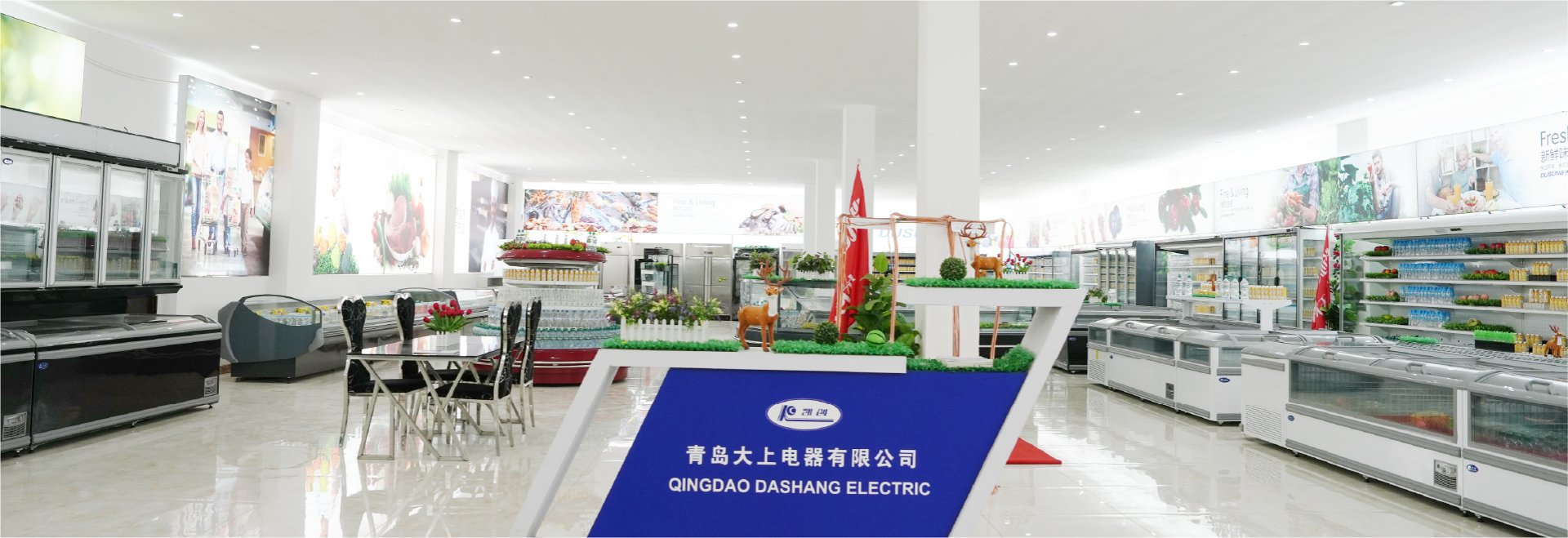Part 1: Popular Commercial Freezer Models in 2025
1. Glass-Door Island Freezer
Technical Features: A large viewing window, three sliding glass doors (can be opened to two-thirds of the way), and a spacious loading/unloading area. Low-e anti-condensation glass improves insulation and energy efficiency. Equipped with a combined forced-air and direct cooling system, it consumes only one-quarter the power of traditional fan-cooled island cabinets.
Application: Supermarkets, warehouse stores, fresh food markets
Storage Products: Suitable for -18℃/-22℃, used for storing ice cream, seafood, dumplings, and frozen meats.

2. Open Display Fridge
Technical Features: Dual air curtains act like doors to block heat exchange, ensuring uniform temperature and rapid cooling (30 minutes). A night curtain saves energy, and built-in ventilation holes prevent condensation. LED lights are installed on the top and shelves, which are adjustable.
Application: Supermarkets, convenience stores
Storage Products: Typically 0℃/+8℃, used for storing vegetables, fruits, dairy products, and beverages.

3. Upright Glass-Door Display Fridge
Technical Features: A large glass door provides an excellent view. Double-layered glass enhances insulation and reduces energy consumption. Bottom-mounted fans ensure even cooling and a sleek appearance. Adjustable shelves with LED lighting.
Application: Supermarkets, convenience stores
Storage Products: Ideal for storing beverages, dairy products, and other chilled items.

4. Counter Food Display Cabinet
Technical Features: Made with 304 stainless steel for easy cleaning and preventing bacterial growth. Double-layered tempered glass ensures durability. The top glass door reduces cold air loss and improves insulation.
Application: Supermarkets
Storage Products: Suitable for fresh meat, seafood, and other perishables.

Part 2: Scientific Guide to Using Commercial Refrigerators (Key to Extending Equipment Lifespan)
1. Preparations
Moving: Avoid collisions or tilting at angles exceeding 45° to prevent damage to the refrigeration system. Allow at least 30 minutes of stabilization after moving before powering on.
Spacing: Ensure 10 cm of space around all sides for proper ventilation. Keep away from heat sources (e.g., stoves, ovens) and direct sunlight to maintain efficient cooling.
Power Supply: Voltage requirements: 115V/60Hz or 220-240V/50Hz/60Hz. Use a voltage stabilizer if fluctuations occur. For initial operation, run the unit empty for 3 hours in summer and 2 hours in winter before adding food.
Item Placement: Leave gaps between items to allow proper airflow. Do not invert transparent glass doors or place heavy objects on them to avoid breakage. Avoid storing acidic, alkaline, or salty foods that may corrode the interior.
2. Operation Guidelines
Temperature Range: Refrigeration: 0–8℃; Freezing: ≤-18℃. Keep the thermostat away from heat sources and ensure it is dry.
Power Cycles: Wait 5 minutes before restarting after shutting down or experiencing a power outage to protect the compressor.
3. Maintenance Tips
Cleaning: Unplug the unit before cleaning. Use a damp cloth with neutral cleaner for internal surfaces. Avoid acidic or corrosive agents.
Condenser Care: Clean the condenser monthly with a soft brush or vacuum. For heavy oil buildup, use a specialized cleaner.
Dust Filter Cleaning: Remove and clean the dust filter regularly by accessing the lower trim panel.
Post-Cleaning: Use compressed air to blow dust off the condenser fins (avoid blowing directly at the fan). Check the compressor and fan operation quarterly.
Disposal: Contact a professional recycling company for disposal. Do not dismantle the unit yourself. Keep foam materials away from heat sources to prevent fire hazards.
Part 3: Common Faults and Solutions
| Fault Phenomenon | Possible Causes | Solutions | Level of Assistance Needed |
|---|---|---|---|
| Compressor not starting | Power supply issues or loose plugs | Check connections | User can troubleshoot |
| High temperature inside | Dirty condenser | Clean the condenser | User can troubleshoot |
| Frequent shutdowns | Voltage instability | Install a stabilizer or adjust voltage | Professional assistance |
| Temperature issues due to poor door seal | Obstructions or worn gaskets | Adjust items or replace gaskets | User/Professional |
| Excessive noise | Cabinet movement or compressor spring failure | Secure the cabinet or replace springs | Professional assistance |
| Continuous operation but low temperature | Faulty thermostat sensor | Replace the sensor | Professional assistance |
Final Thoughts
Every commercial refrigerator requires a customized cooling solution tailored to your specific business needs. Click below to receive a free customized commercial cooling solution!









